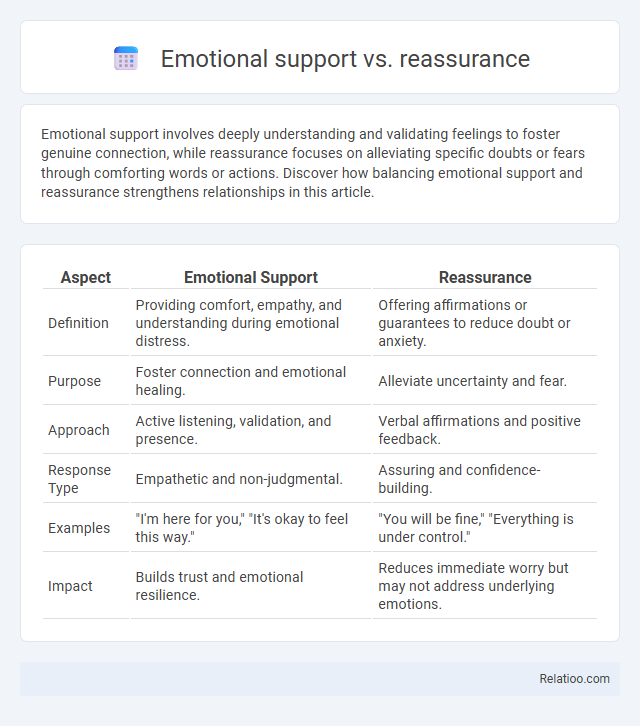Emotional support involves deeply understanding and validating feelings to foster genuine connection, while reassurance focuses on alleviating specific doubts or fears through comforting words or actions. Discover how balancing emotional support and reassurance strengthens relationships in this article.
Table of Comparison
| Aspect | Emotional Support | Reassurance |
|---|---|---|
| Definition | Providing comfort, empathy, and understanding during emotional distress. | Offering affirmations or guarantees to reduce doubt or anxiety. |
| Purpose | Foster connection and emotional healing. | Alleviate uncertainty and fear. |
| Approach | Active listening, validation, and presence. | Verbal affirmations and positive feedback. |
| Response Type | Empathetic and non-judgmental. | Assuring and confidence-building. |
| Examples | "I'm here for you," "It's okay to feel this way." | "You will be fine," "Everything is under control." |
| Impact | Builds trust and emotional resilience. | Reduces immediate worry but may not address underlying emotions. |
Understanding Emotional Support: A Core Need
Emotional support involves active listening and empathy, providing a safe space for individuals to express feelings without judgment. Reassurance focuses on affirming safety and stability, helping to alleviate anxiety through consistent, positive feedback. Reconnection emphasizes restoring bonds and emotional intimacy, reinforcing trust and a sense of belonging critical for mental well-being.
What Is Reassurance? Defining the Concept
Reassurance involves providing clear, calm communication to alleviate someone's anxiety or doubts by confirming facts or outcomes, often addressing specific concerns or fears. Unlike emotional support, which focuses on empathy and understanding feelings, reassurance aims to reduce uncertainty through affirmation and factual evidence. Reconnection emphasizes rebuilding trust and emotional bonds, while reassurance centers on instilling confidence and certainty in the moment.
Key Differences Between Emotional Support and Reassurance
Emotional support involves understanding and validating your feelings, offering empathy and a safe space to express emotions, whereas reassurance focuses on alleviating doubts and providing confidence through affirmations or factual information. Emotional support nurtures long-term emotional resilience by acknowledging your experience, while reassurance targets immediate relief from anxiety or uncertainty. Recognizing these key differences helps you seek the right approach for deeper emotional healing or quick relief.
Psychological Impact of Emotional Support
Emotional support significantly enhances mental well-being by providing validation, reducing feelings of isolation, and fostering resilience against stress and anxiety. Reassurance offers temporary relief by alleviating immediate fears but may not address deeper psychological needs or promote long-term emotional stability. Reconnection strengthens interpersonal bonds, contributing to a secure attachment framework that underpins emotional health and encourages sustained psychological recovery.
The Short-Term Effects of Reassurance
Reassurance provides immediate relief by reducing anxiety and stress through affirming statements or actions, giving your mind a temporary sense of security. Unlike emotional support, which fosters long-term coping skills, reassurance often addresses short-term worries without resolving underlying issues. This brief comfort can prevent panic but may lead to dependency if relied on excessively.
When Reassurance Becomes Counterproductive
Reassurance provides temporary relief from anxiety but can become counterproductive when overused, fostering dependency and reinforcing fears instead of resolving them. Emotional support focuses on validating feelings and encouraging coping strategies, helping you build resilience and self-confidence without relying on constant reassurance. Reconnection emphasizes restoring trust and strengthening relationships, which is essential once excessive reassurance has undermined your emotional autonomy.
Building Genuine Emotional Connections
Emotional support involves actively listening and validating feelings to foster trust and safety, essential for building genuine emotional connections. Reassurance offers comfort by alleviating doubts and fears, but without deeper engagement, it may not create lasting bonds. Reconnection emphasizes reestablishing meaningful interactions after distance or conflict, strengthening emotional intimacy through shared vulnerability and understanding.
Practical Ways to Offer Emotional Support
Offering emotional support involves active listening, validating Your feelings, and expressing empathy to create a safe space for open communication. Reassurance focuses on comforting by affirming stability and reliability through consistent, honest reminders of Your strengths and positive outcomes. Reconnection requires proactive efforts such as shared activities or heartfelt conversations to rebuild trust and strengthen emotional bonds practically.
Recognizing Requests for Reassurance vs Support
Recognizing requests for reassurance versus support involves understanding the underlying emotional needs conveyed in your interactions. Reassurance often seeks validation and answers to alleviate doubt, while emotional support aims to provide empathy and comfort without necessarily solving the problem. Your ability to distinguish between these requests enhances communication effectiveness and deepens relational connections.
Empowering Others: Moving Beyond Reassurance
Empowering others involves providing emotional support that fosters self-confidence and resilience rather than merely offering reassurance, which can create dependency and short-term relief. Emotional support facilitates authentic reconnection by validating feelings and encouraging individuals to trust their own judgment and experiences. Your role shifts from giving temporary comfort to enabling meaningful growth and lasting empowerment through genuine understanding and connection.

Infographic: Emotional support vs reassurance
 relatioo.com
relatioo.com